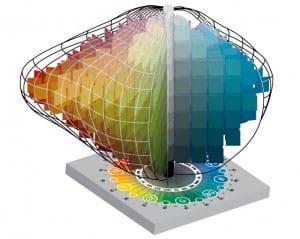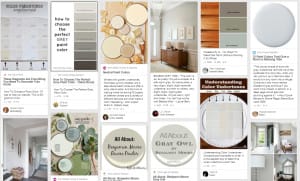Have you heard the news? Scientists in the US believe they have come up with a solution which could see a reprieve for incandescent bulbs.
Without light, there is no color. That’s a fact.
We humans have a long and affectionate history with incandescent light. We love the stuff. So much so that when rumors first flared that incandescent light bulbs would be “banned” people started hoarding them.
Why? Because objects illuminated by incandescent light matches how we see objects in natural daylight. (article offers more detail) I hope the scientists are able to bring the new and improved incandescent light bulbs to market soon.
It seems daylight is the most popular quality of light to mimic. Understanding the importance of daylight-quality-illumination to how humans perceive color, professional standards for measuring color specify a light source that represents indirect daylight at noon. It’s called D65 and it’s key to how a color’s hue family and other attributes are determined.

I’m launching my new online color training program The Four Pillars of Color the end of this month. It’s all about the three dimensions of color hue, value and chroma – what I like to call color DNA. I’ve been banging the drum about color order systems and notations that include hue angles and families for many, many years.
While flocks have been chasing the fastest and easiest shortcuts for working with color, I have been the lone voice saying, “Hey, wait a second… you all do know other, more effective color systems already exist — and they come with scientific provenance — and professional reference, some going back more than 100 years.”
It was easy to get the attention of those who are abundantly talented and color smart but are driven to be color educated as well. Many of them have tried the fast and easy shortcuts and it’s just not enough to quench their thirst for substantial color knowledge.

One of the questions I get a lot is, “I’m almost embarrassed to ask because I feel like I should know this, but where do hue families come from?”
And this is where that all-important factor of daylight comes back into our conversation.
Colors are illuminated with a daylight-like source and then measured with a device. One of the things the device measures is the wavelengths that make up the color – again, think of it as the color’s DNA. The strongest or most prominent wavelength in the color’s DNA is its hue family.

If you’re lucky enough to come across a collection of colors that have color notations including hue family, you know you have an accurate and objective piece of color data to work with.
A hue family designation ascertained via standard is information you can count on because it’s not dependent on someone else’s opinion of a color. A color notation is objective, not subjective.

There is no shortage of subjective color opinion. The image above is a small sample of what you’ll find just on Pinterest. Beware of random information like this because when you accept someone else’s subjective color opinion as being fact, you are assuming that person has the acuity to consistently see color accurately. You’re also accepting all the personal baggage and past color experiences that informs how they perceive color. Essentially, they’re making their best guess about color — in their “normal” viewing conditions — and are expecting you to blindly buy into their opinion.
Why would you settle for that?
Color notations that include hue family are like a color’s bio, read it and you know the color. Confident that it’s accurate, consistent, objective information. With that said, and as wonderfully useful as colorimetry is to anyone who works with color, I like to remind people of this:

I’d love to have you join me in The Four Pillars of Color course. Here’s how to sign up.

Great article on hue families! I am intrugued by the whole incandescent lightbulb revival. It is extremely important to have proper lighting, or the colors you pick when decorating your home will not look as you intended. I can’t wait to see how everything turns out. The eLearning module you spoke about seems interesting, and I will definitely be looking into it to further my color knowledge. Thank you!
Julie~FurnishMyWay
Thank you for relaying this exciting information on incandescent technology. This made my day! As a color consultant, those icky, greenish fluorescent bulbs have been the bane of my existence. It’s hard to find any color that looks good under them. If MIT’s bulb works, looks like it will be a win-win: looks better, costs less to operate, and is even more efficient than LEDs. Great news.